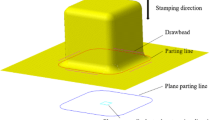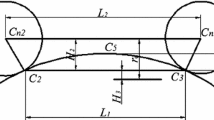Abstract
The existing pre-joining processes optimization methods divide the panel into many units, and then absolutely optimize the pre-joining processes for these units, which do not take into account the influence of the clearances flow among units on the determination of pre-joining processes. To solve the abovementioned problem, this paper presents an optimized method of pre-joining processes for panel to establish the processes correlation among units, by considering the clearances flow among units based on the optimization of pre-joining processes for units. Firstly, take the pre-joining path optimization and the less residual clearances as the combined aims, consider the panel structure and the space constraints as conditions, and establish a planning model of pre-joining sequences among units of panel. Afterwards, based on the pre-joining sequences of units of the panel, analyze the influence of pre-joining of the current unit on the clearances of adjacent unit; set up a calculation model of clearances flow among units; subsequently, build up the pre-joining model for units with meeting to permissive clearances after pre-joining, to optimize the number, location, and sequence of pre-joining points for units; and finally, based on abovementioned models, present an optimization method of pre-joining processes orienting to the clearances suppression of units and the clearances flow among units. The effectiveness of the proposed method in the current paper was verified by a pre-joining example. The result has shown that (1) based on the previous study of pre-joining only for units, the current paper has proposed the model of clearances flow among units, and the prediction error of this model is 10% comparing with the experiment value; (2) according to the optimized pre-joining sequence among units and the finite element simulation of clearances flow among units, the pre-joining affection of the current unit will lead to that the initial clearances of the adjacent unit has a slight increase by 9%, and there is no problem of wrinkle for the panel in that the clearances flow out; and (3) the proposed method has took the units of panel as the object, studied the mechanisms for the clearances suppression of units and the clearances flow among units, and established the optimization manner of pre-joining processes for the panel to reduce the clearances of panel and the number of pre-joining points.
Similar content being viewed by others
References
Lee S, Tang JS, Chu CL (2016) Size effect in gas forming a hot-bent AA5xxx V-shaped trough trimmed for an airplane strakelet skin panel. Int J Adv Manuf Technol 86(9–12):2747–2752
Saadat M, Cretin L, Sim R, Najafi F (2009) Deformation analysis of large aerospace components during assembly. Int J Adv Manuf Technol 41(1–2):145–155
Peng JW, Li WD, Han JQ, Wan M, Meng B (2016) Kinetic locus design for longitudinal stretch forming of aircraft skin components. Int J Adv Manuf Technol 86(9–12):3571–3582
Sun XF, Shehab E, Mehnen J (2013) Knowledge modelling for laser beam welding in the aircraft industry. Int J Adv Manuf Technol 66(5–8):763–774
Cheng H, Li Y, Zhang K, Su JB (2011) Efficient method of positioning error analysis for aeronautical thin-walled structures multi-state riveting. Int J Adv Manuf Technol 55(1–4):217–233
Nezamdost MR, Esfahani MRN, Hashemi SH, Mirbozorgi SA (2016) Investigation of temperature and residual stresses field of submerged arc welding by finite element method and experiments. Int J Adv Manuf Technol 87(1–4):615–624
Liu G, Tang W, Ke YL, Chen QL, Bi YM (2014) Modeling of fast pre-joining processes optimization for skin-stringer panels. Assem Autom 34(4):323–332
Liu G, Tang W, Ke YL, Chen QL, Chen XM (2015) Pre-joining process planning model for a batch of skin-stringer panels based on statistical clearances. Int J Adv Manuf Technol 78(1):41–51
Yang D, Qu WW, Ke YL (2016) Evaluation of residual clearance after pre-joining and pre-joining scheme optimization in aircraft panel assembly. Assem Autom 36(4):376–387
Cheng H, Li Y, Zhang KF, Mu WQ, Liu BF (2011) Variation modeling of aeronautical thin-walled structures with multi-state riveting. J Manuf Syst 30(2):101–115
Cheng H, Wang RX, Li Y, Zhang KF (2012) Modeling and analyzing of variation propagation in aeronautical thin-walled structures automated riveting. Assem Autom 32(1):25–37
Aman F, Cheraghi SH, Krishnan KK, Lankarani H (2013) Study of the impact of riveting sequence, rivet pitch, and gap between sheets on the quality of riveted lap joints using finite element method. Int J Adv Manuf Technol 67(1–4):545–562
Liu SC, Hu SJ (1997) Variation simulation for deformable sheet metal assemblies using finite element methods. Trans ASME J Manuf Sci Eng 119(3):368–374
Dahlstrom S, Lindkvist L (2007) Variation simulation of sheet metal assemblies using the method of influence coefficients with contact modeling. Trans ASME J Manuf Sci Eng 129(3):615–622
Bi YB, Wu YH, Zhu WD, Shen LH, Huang W, Zhu Y (2015) Pre connected process optimization of aircraft stacks. J ZJU(Eng Sci) 49(11):2040–2046 In Chinese
Qu WW, Tang W, Bi YB, Li SB, Luo SJ (2016) Pre-joining processes plan to avoid forced assemblies and improve efficiency. J ZJU(Eng Sci) 50(8):1561–1569 In Chinese
Jie L (2013) The formation and effect of interlayer gap in dry drilling of stacked metal materials. Int J Adv Manuf Technol 69(5–8):1263–1272
Saeed Moaveni (2013) Finite element analysis theory and application with ANSYS. Publisher: Electronic Industry Press
Shan HZ (2009) Material mechanics (I). Higher Education Press, Publisher In Chinese
Szolwinski MP, Farris TN (2000) Linking riveting process parameters to the fatigue performance of riveted aircraft structures. J Aircraft 37(1):130–137
Ann WZ (2013) Study of the occupant crash protection performance of the negative Poisson’s ratio seat belt webbing. Dalian University of Technology, Dalian In Chinese
Author information
Authors and Affiliations
Corresponding author
Rights and permissions
About this article
Cite this article
Qu, WW., Tang, W. & Ke, YL. Pre-joining processes optimization method for panel orienting to the clearances suppression of units and the clearances flow among units. Int J Adv Manuf Technol 94, 1357–1371 (2018). https://doi.org/10.1007/s00170-017-0973-y
Received:
Accepted:
Published:
Issue Date:
DOI: https://doi.org/10.1007/s00170-017-0973-y




